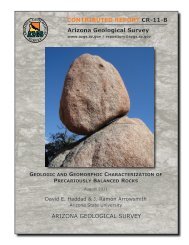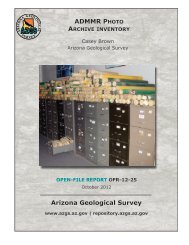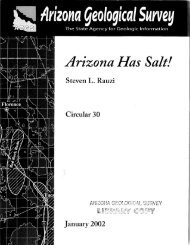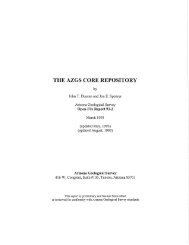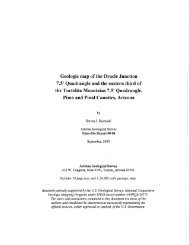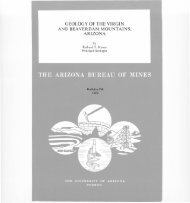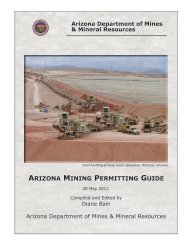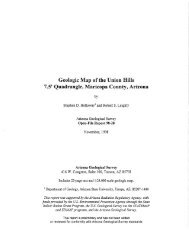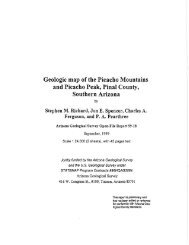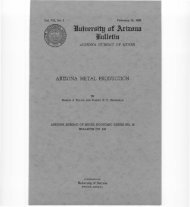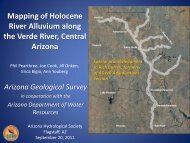Subsurface Geologic Investigation of Fountain Hills - AZGS ...
Subsurface Geologic Investigation of Fountain Hills - AZGS ...
Subsurface Geologic Investigation of Fountain Hills - AZGS ...
Create successful ePaper yourself
Turn your PDF publications into a flip-book with our unique Google optimized e-Paper software.
Tsp Pemberton Ranch Formation (Late Tertiary). Very fine-grained, tan- to<br />
brown-colored siltstone, claystone, fine-grained sandstone, and minor coarser<br />
grained sandstone and conglomerate. Generally, the unit is thinly bedded with<br />
bedding planes defined by fissle partings on weathered surfaces. Locally,<br />
interbedded sand layers form small lenses tens <strong>of</strong> centimeters wide. Mud cracks<br />
are visible locally. Small tubular carbonate concretions several millimeters in<br />
diameter and 1-3 cm long may be root casts or burrows. In some drill cuttings the<br />
sticky clay and silt rolls into coarse sand-size fragments. If not observed closely,<br />
these fragments can easily be misidentified as coarse siliciclastic sand. The unit<br />
commonly contains minor amounts <strong>of</strong> calcite and possibly very minor gypsum.<br />
Named by Pope (1974) as the Pemberton Silt.<br />
Tsn Needle Rock Formation (Late Tertiary). Clast-supported conglomerates and<br />
debris flows composed almost entirely <strong>of</strong> subrounded clasts <strong>of</strong> basalt ranging<br />
from pebble-size to 0.5 meters across, all in a silty to sandy matrix <strong>of</strong> quartz,<br />
feldspar, and basalt. The matrix is cemented by abundant calcite spar. Medium<br />
bedded. Bedding is visible up close but is best seen from a distance. Bedding is<br />
steeper near bedrock contacts. These deposits grade laterally into finer-grained<br />
sediments <strong>of</strong> the Pemberton Ranch Formation.<br />
Tc Red beds (Middle Tertiary). Interbedded matrix-supported breccia, and clast<br />
supported conglomerate, sandstone, and minor siltstone and limestone. Breccia<br />
layers are matrix-supported, very poorly sorted, weakly to non-bedded, and<br />
contain outsized clasts up to 10 meters across, and probably represent debris<br />
flows. Locally interbedded with and intruded by mafic volcanic rocks. Clasts<br />
include granite and metamorphic rock, and only rare basaltic rocks. In exposed<br />
outcrops this unit is cemented with silica rather than carbonate. However, red<br />
grussy conglomerate obtained from the only drill core sample in this study (HSI,<br />
2002a) was cemented with carbonate. Thus, this unit may be cemented by<br />
carbonate at depth.<br />
22



